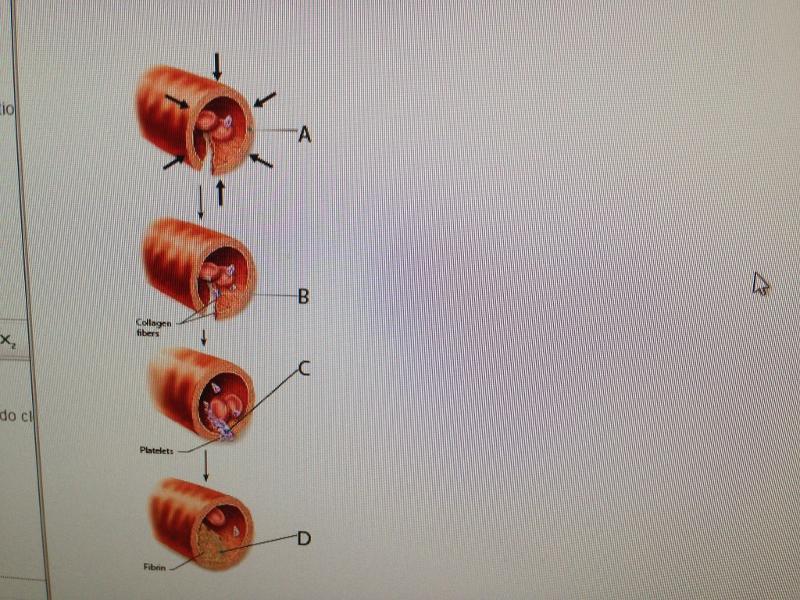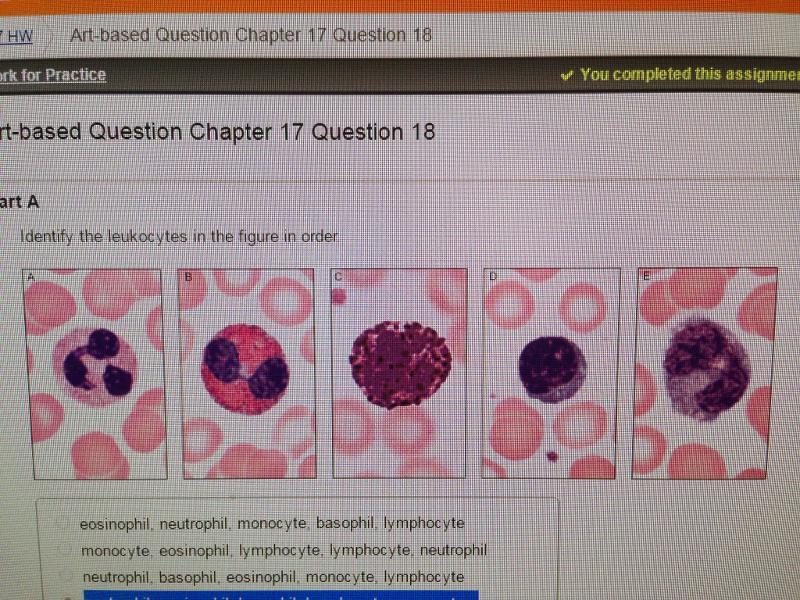
1.Art-based Question
During which event of hemostasis do
clotting factors (procoagulants) assist with the transformation of
blood from a liquid to a gel?
A
B
C
D
D
2.Hemostasis is important for __________.
stoppage of
bleeding
white blood cell production
red blood cell
production
red blood cell recycling
stoppage of bleeding
3.Which step in hemostasis involves activation of formed elements in
the blood?
vascular spasm
coagulation
platelet plug
formation
fibrin production
platelet plug formation
4.Which of the following represents a difference between extrinsic
and intrinsic blood clotting pathways?
One is triggered by tissue
damage, while the other cannot be triggered by tissue damage.
One
involves calcium ions, while the other does not.
One is faster
than the other.
One leads to the production of prothrombin
activator and the other does not.
One is faster than the other.
5.Which of the following would NOT lead to a bleeding
disorder?
thrombocytopenia
vitamin K
deficiency
impaired liver function
excess calcium in the diet
excess calcium in the diet
6.A person who lacks agglutinogen A but has agglutinogen B would have
blood type __________.
AB
B
O
A
B
7.Choose the incompatible transfusion.
Donate type B blood to a
recipient with type O blood.
Donate type A blood to a recipient
with type AB blood.
Donate type B blood to a recipient with type
AB blood.
Donate type O blood to a recipient with type AB blood.
Donate type B blood to a recipient with type O blood.
8.
Which ABO blood type is considered to be the universal recipient?
O
A
AB
B
AB

9.Art-based Question
Identify the leukocytes in the figure in
order.
eosinophil, neutrophil, monocyte, basophil,
lymphocyte
monocyte, eosinophil, lymphocyte, lymphocyte,
neutrophil
neutrophil, basophil, eosinophil, monocyte,
lymphocyte
neutrophil, eosinophil, basophil, lymphocyte, monocyte
neutrophil, eosinophil, basophil, lymphocyte, monocyte
10.From which cell do the granulocytes
descend?
myeloblast
monoblast
promonocyte
lymphoid
stem cell
myeloblast
11.On a blood smear slide prepared using Wright's stain, you observe
a large cell with a U-shaped nucleus and pale blue cytoplasm. This
cell is most likely a(n) __________.
basophil
monocyte
eosinophil
lymphocyte
monocyte
12.Which type of leukocyte is responsible for antibody production?
basophils
monocytes
eosinophils
lymphocytes
lymphocytes
13.Which of the following does NOT stimulate erythrocyte
production?
testosterone
hyperventilating
a drop in
normal blood oxygen levels
erythropoietin
hyperventilating
14.Which of the following are primary lymphoid organs?
lymph
nodes and tonsils
bone marrow and thymus
appendix and
spleen
spleen and thymus
bone marrow and thymus
15.Which of the following areas in a secondary lymphoid organ allows
intimate contact between blood and the lymphocytes?
germinal
centers of the lymph nodes
white pulp of the spleen
red pulp
of the spleen
Hassall’s corpuscles of the thymus
white pulp of the spleen
16-Where in the lymph node do the T cells first encounter antigens
presented by dendritic cells?
medullary cords in the
medulla
lymphoid follicles of the outer cortex
germinal
centers of the cortex
deep in the cortex
deep in the cortex
17.Collections of lymphoid tissues, called MALT, are strategically
placed throughout the respiratory, digestive, and genitourinary
systems. Which one of these is located at the end of the small
intestine?
Peyer’s patches
appendix
tonsils
Peyer’s patches
18.There is a decrease in our ability to fight infection as we age. Which lymphoid organ may have a role in this decline?
spleen
thymus
lymph nodes
thymus
19.Besides lymph nodes, where would you expect to find proliferating
(dividing) B cells?
in the brain
in the thyroid
in the
skin
in the spleen
in the spleen
20. Which of the following mechanisms is NOT used to propel lymph
through lymphatic vessels?
small heart-like
pumps
gravity
the milking action of muscles
pulmonary motion
small heart-like pumps
21. Adjacent cells in lymphatic capillaries overlap each other
loosely. What is the unique structural modification that increases
their permeability?
lacteals
minivalves
fibroblasts
trabeculae
minivalves
22.Which of the following promotes closure of the minivalves
associated with lymph capillaries?
increasing pressure in the
interstitial space
anchoring of endothelial cells to adjacent
structures by collagen fibers
increasing pressure inside the
lymph capillary
inflammation of tissues surrounding lymphatic capillaries
increasing pressure inside the lymph capillary
23. Lymph from what regions of the body is drained into the right
lymphatic duct?
the left upper limb, the left side of the head
and thorax, and both lower limbs
the right upper limb, the right
side of the head, and the thorax
the right upper limb, the right
side of the head and thorax, and the right lower limb
the
digestive organs and lower limbs
the right upper limb, the right
side of the head, and the
thorax
24.What is the name of the enlarged sac to which the lumbar trunks
and the intestinal trunk return lymph?
cisterna
chyli
thoracic duct
lacteals
right lymphatic duct
cisterna chyli
25.What region of the lymph node contains follicles filled with
dividing B cells?
hilus
cortex
subcapsular sinus
medulla
cortex
27.Which lymph cells produce antibodies?
dendritic
cells
macrophages
plasma cells
reticular cells
plasma cells
27. Which statement describes the origin of lymph fluid?
Lymph
is collected from atrial to venous anastomoses.
Lymph is secreted
into the lymph vessels.
Lymph is collected from fluid that
accumulates in veins as blood slowly circulates back toward the
heart.
Lymph is excess fluid formed from plasma that accumulates
in the tissues as interstitial fluid.
Lymph is excess fluid formed from plasma that accumulates in the tissues as interstitial fluid.
28. Where are the three large clusters of superficial lymph
nodes?
the cervical, acromial, and mammary regions
the
axillary, brachial, and subclavian regions
the lumbar, inguinal,
and femoral regions
the cervical, inguinal, and axillary regions
the cervical, inguinal, and axillary regions
29.Once collected, lymph ultimately drains into
__________.
lymph nodes
arterial circulation
venous
circulation
the liver for detoxification
venous circulation
30. Art-based Question
Which lymphoid organ extracts aged and
defective blood cells and platelets from the blood in addition to
storing some of the breakdown products for later reuse?
A
B
C
D
C
31.Which of the following is a role of lymph nodes?
They produce
red blood cells.
They return lymph to circulation.
They
filter lymph.
They produce lymph.
They filter lymph.
32.Which part of the spleen is the site of immune
function?
splenic sinusoids
red pulp
white
pulp
splenic cords
white pulp
33. After surgical removal of the spleen (i.e., a splenectomy), some
other organs take over most of its functions. Which of the following
spleen functions in the adult can not be performed by bone
marrow?
immune surveillance
erythropoiesis
removal of
aged and damaged red blood cells from the blood
storage of platelets
removal of aged and damaged red blood cells from the blood
34. Which of the following lymph organs is NOT matched with its
function?
thymus: mature T cells
Peyer's patches: mature B
cells
bone marrow: form lymphocytes
spleen: remove red blood cells
Peyer's patches: mature B cells
35. Peyer's patches are mucosa-associated lymph tissue located in the
__________.
wall of the small intestine
spleen
wall of
the colon
liver
wall of the small intestine
36-The muscular layer in the wall of a blood vessel is the
tunica intima.
tunica externa.
tunica media.
tunica interna.
tunica media.
37-Compared to arteries, veins
are more elastic.
have
more smooth muscle in their tunica media.
have a pleated
endothelium.
have thinner walls.
have thinner walls.
38-Capillaries that have a complete lining are called
continuous capillaries.
fenestrated capillaries.
sinusoidal capillaries.
sinusoids.
continuous capillaries.
39-The smallest arterial branches are called the
precapillary
arterioles.
arterioles.
capillaries.
venules.
precapillary arterioles.
40-The layer between the tunica media and the tunica externa in a
large artery is the
tunica intima.
external elastic
membrane.
tunica media.
internal elastic membrane.
tunica externa.
external elastic membrane.
41-The thoroughfare channel ends at the
artery.
arteriole.
capillary.
venule.
vein.
venule.
42-Which of the following layers of a vessel contains collagen fibers
with scattered bands of elastic fibers?
tunica intima
external elastic membrane
tunica media
internal
elastic membrane
tunica externa
tunica externa
43-After blood leaves the capillaries, it enters the
arteries.
arterioles.
capillaries.
venules.
veins.
venules.
44-Which layer of a blood vessel contains concentric sheets of smooth
muscle tissue?
tunica intima
external elastic membrane
tunica media
internal elastic
membrane
tunica externa
tunica media
45-The large vessels that return blood to the heart are called
arteries.
arterioles.
capillaries.
venules.
veins.
veins.
46-11.
In large arteries, the thick layer of elastic fibers is
called the
tunica intima.
external elastic membrane.
tunica media.
internal elastic membrane.
tunica externa.
internal elastic membrane.
47-Which of the following is the innermost layer of a blood vessel?
tunica intima
external elastic membrane
tunica
media
internal elastic membrane
tunica externa
tunica intima
48-Venoconstriction ________ the amount of blood within the venous
system, which ________ the volume in the arterial and capillary
systems.
doubles; decreases
reduces; increases
decreases; doubles
increases; reduces
reduces; reduces
reduces; increases
49-Venous valves are responsible for
preventing anterograde
flow.
channeling blood away from the heart.
channeling
blood toward the heart.
preventing blood from re-entering a
ventricle.
regulating blood pressure in veins.
channeling blood toward the heart.
50-Venae cavae are the largest of what type of vessel?
artery
arteriole
capillary
venule
vein
vein
51-The layer of the arteriole wall that can produce vasoconstriction
is the
tunica adventitia.
tunica media.
tunica
intima.
tunica externa.
tunica mater.
tunica media.
52-Of the following arteries, the one that is an elastic artery is
the subclavian artery.
the external carotid artery.
the
brachial artery.
the femoral artery.
the ulnar artery.
the subclavian artery.
53-Which of the following lumen diameters would be typical of a
muscular artery?
0.2 mm
1.0 cm
0.4 mm
0.4 cm
0.5 cm
0.4 cm
55-Which vessel is known as a resistance vessel?
arteriole
elastic
connective
muscular
venule
arteriole
55-The main control of peripheral resistance occurs in the
arterioles.
venules.
veins.
arteries.
capillaries.
arterioles.
56-Resistance is a force that
increases blood flow.
decreases blood flow.
never changes in a blood vessel.
acts with pressure to move blood along a vessel.
is always
higher than blood pressure.
decreases blood flow.
57-Total peripheral resistance is related to all of the following,
except the
length of a blood vessel.
osmolarity of
interstitial fluids.
turbulence.
blood viscosity.
blood vessel diameter.
osmolarity of interstitial fluids.